Bird species of the week
Magnificent Frigatebird (Fregata magnificens)
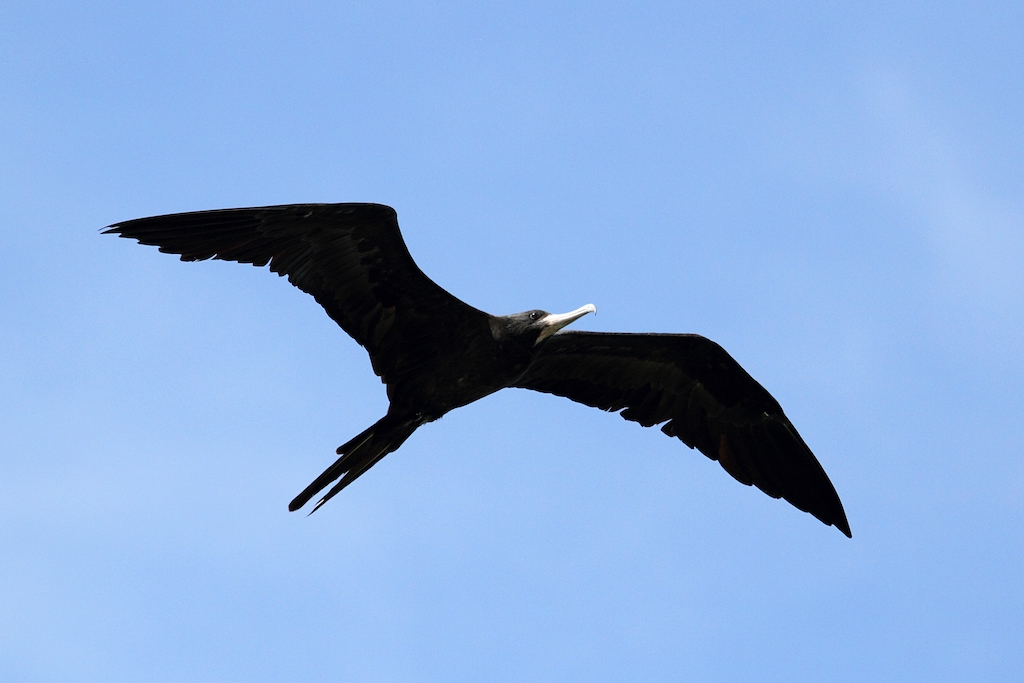
Description
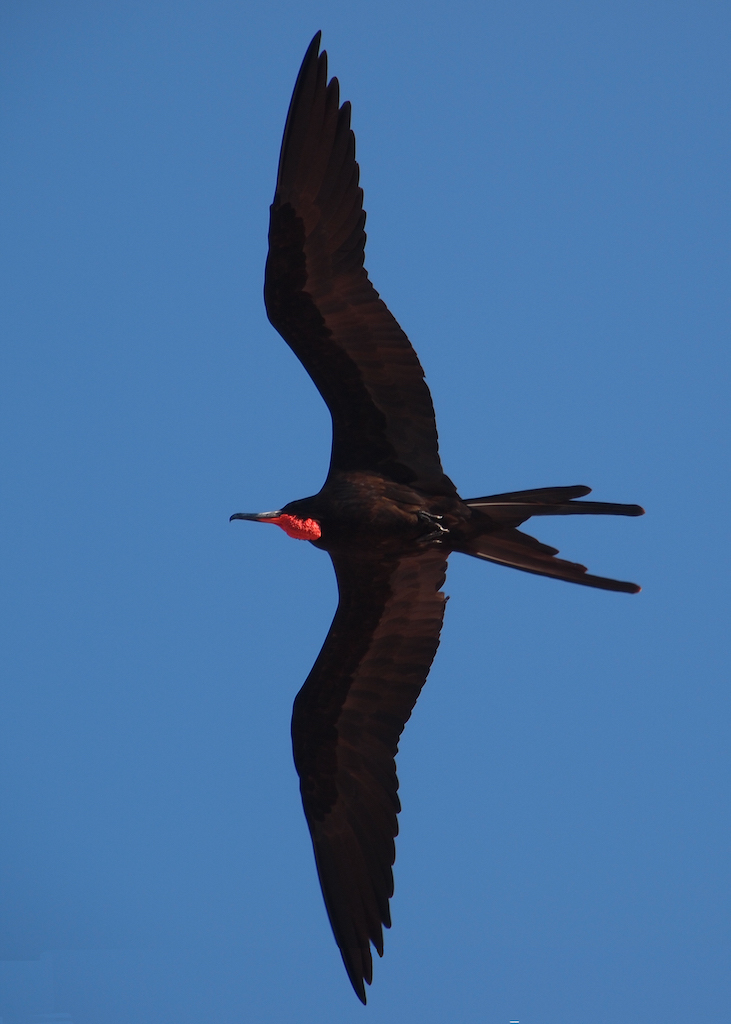
Beachgoers delight in this large, black pterodactyl-like bird that soars effortlessly on tropical breezes with hardly a flap, using its deeply forked tail to steer. Watching a Magnificent Frigatebird float in the air truly is, as the name implies, magnificent. These master aerialists are also pirates of the sky, stealing food from other birds in midair. Males have a bright red pouch on the throat, inflating like a balloon to attract females. Females unlike most other seabirds look different than males with their white chest.
Cool facts
Frigatebirds are the only seabirds in which the male and female look strikingly different. Females may not have the males’ bright red pouch, but they are bigger than males.
The breeding period of the Magnificent Frigatebird is exceptionally long. Males and females incubate the eggs for around 56 days, and once hatched, chicks don’t leave the nest until they are about 167 days old. Even after they leave the nest, females continue to feed them until they are one year old.
The Magnificent Frigatebird spends most of its life flying effortlessly over the ocean. It rarely lands on the water even though it has webbed feet, because unlike other seabirds it lacks waterproof feathers.
The frigatebird is sometimes called the «man-o-war bird» because it harasses other birds until they regurgitate recently captured food, which the frigatebird snatches in midair.
Learning how to chase other birds and steal meals takes practice. Young frigatebirds hold sticks in their mouths and chase each other. When one of them drops the stick, the other dives below to retrieve it.
The oldest known Magnificent Frigatebird was at least 19 years, 9 months old when it was recaptured and rereleased in the Lesser Antilles during a scientific study.
Where to see it?

Magnificent Frigatebirds soar along the coast in the southern United States, Mexico, Central America, part of South America, and the Caribbean staying near water; a perfect excuse for a walk on the beach. They tend to take flight later in the afternoon when winds and thermals are greatest, helping keep them aloft. Look for their long and angular wings and slender silhouette soaring effortlessly alone or with a group of frigatebirds. If you hear gulls and seabirds making a ruckus, look up and you might find a frigatebird harassing them for their meal.
Habitat
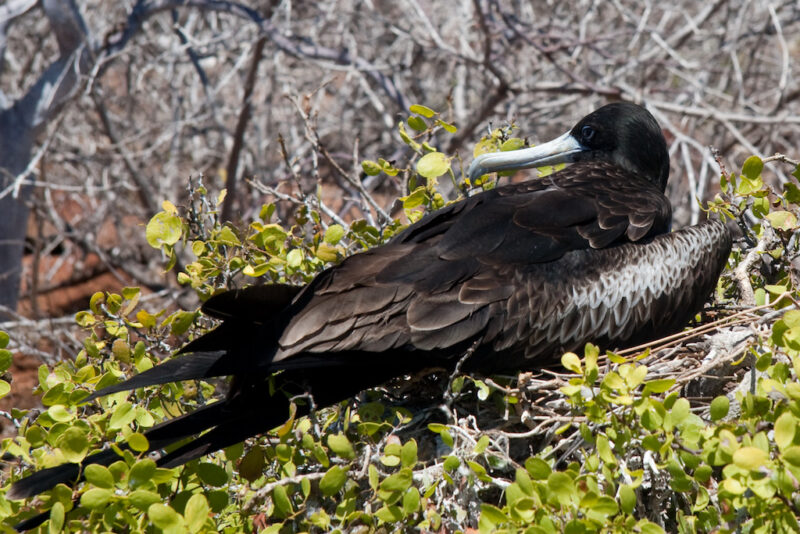
Magnificent Frigatebirds range along coasts and islands in tropical and subtropical waters. They nest and roost in mangrove cays on coral reefs and in low trees and shrubs on islands. Magnificent Frigatebirds forage over warm oceans far out to sea, along the coast, and in shallow lagoons.
Food
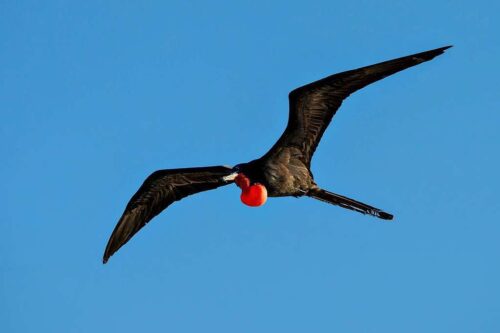
Magnificent Frigatebirds eat primarily flying fish, tuna, herring, and squid, which they grab from the surface of the water without getting wet. They also eat plankton, crabs, jellyfish, and other items on the surface of the water including discarded fish from fishing boats. Magnificent Frigatebirds forage for themselves, but they also chase and harass other seabirds and frigatebirds forcing them to regurgitate recently captured meals, swooping down to steal the meal before it hits the water.
Nesting
Nest Shrub
Magnificent Frigatebirds nest in dense colonies on top of low trees and shrubs on islands. Nests are packed into small areas and are often within striking distance of another nest. The female builds the nest on the display perch used by the male she chooses.
Nest description
The male brings sticks to the female, which she arranges into a flimsy platform about 9-14 inches wide. The male gathers sticks from trees and shrubs but also steals them from other males. Nest building takes about 13 days.
Nesting facts
Clutch Size: 1 egg
Number of Broods: 1 brood
Egg Length: 2.6-2.9 in (6.5-7.4 cm)
Egg Width: 1.7-2.0 in (4.4-5 cm)
Incubation Period: 53-61 days
Nestling Period: 150-185 days
Egg Description: White.
Condition at Hatching: Naked and helpless.
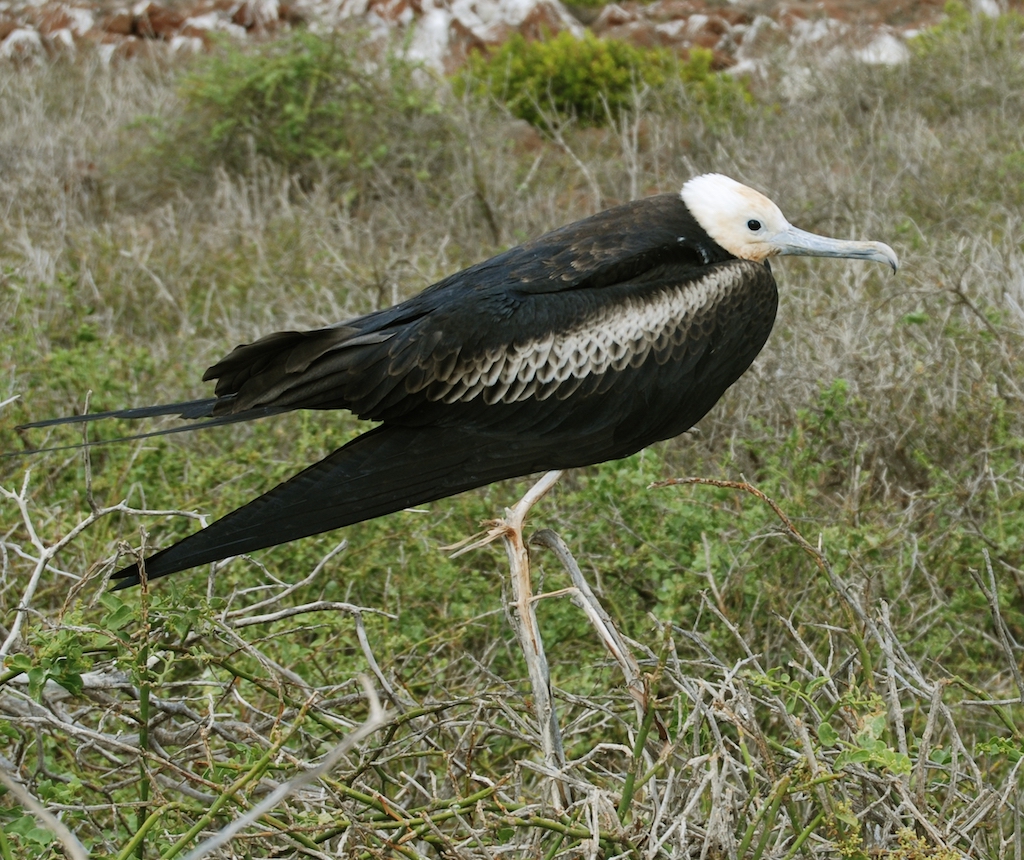
Behavior
Frigatebirds soar effortlessly over the ocean rarely flapping their long, pterodactyl-like wings and using the long tail to steer. Though they are frequently seen soaring, they are masters of pursuit. They chase other birds including frigatebirds, forcing them to regurgitate their recent meal, which they scoop up before it hits the water. Their gracefulness ends as soon as they head towards land, where they awkwardly perch in low shrubs and trees. Their strong toes help them hold onto branches, posts, and boat masts, but their small feet in combination with their short legs make it nearly impossible for them to walk on land. On land, males often flutter the balloonlike throat sac (or «gular pouch») to cool off. Males and females also regulate their body temperature by holding up their wings to sun themselves. To get airborne, they flap a few times and use the wind to help lift them into the air. Male Magnificent Frigatebirds gather in groups to court females. They perch in low trees and shrubs with their red throat sacs inflated like a balloon and clatter their bills, waving their heads back and forth, and calling at females flying overhead. Females choose a mate and begin building a nest on the male’s display perch. The pair stays together for up to 3 months, after which the male leaves, and the female raises the chick alone for up to 1 year.
Conservation
Partners in Flight estimates the global breeding population of Magnificent Frigatebirds at 113,000 and rates them 16 out of 20 on the Continental Concern Score, indicating a species of high conservation concern. Magnificent Frigatebird is also included on the Yellow Watch List-R for species that are not declining but still remain vulnerable due to a small range of population and moderate threats. In areas where they breed, many populations are declining due to urban and resort development. Several islands in the Caribbean, including Marquesas Keys off southern Florida, Aruba, and Seal Key in the Bahamas, no longer support breeding colonies following coastal development. Overfishing, predator introductions on nesting islands, and hurricanes may also reduce nesting success.
